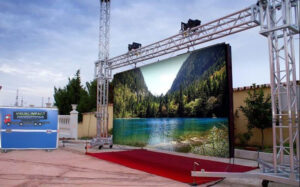Rental Advertising LED Display, often referred to as an LED advertising screen or LED billboard, is a large-scale digital display technology that employs Light Emitting Diodes (LEDs) to showcase dynamic and visually captivating content. These displays are designed for outdoor or indoor use and are commonly used for advertising, marketing, and promotional purposes. Advertising LED Displays offer a highly effective means of conveying messages to a wide audience, making them an integral part of modern advertising strategies. Let’s explore what an Advertising LED Display is, why it is used, and where it finds applications:
What is a Rental Advertising LED Display?

Rental Advertising LED Display consists of an array of individual LED modules or panels arranged to form a screen. These LED modules emit light when an electrical current passes through them, producing bright and vivid colors. The key components of an Advertising LED Display include:
LED Panels: These are the building blocks of the display, each containing numerous LEDs. The size and resolution of the panels determine the overall display size and pixel density.
Control System: A control system, often connected to a computer, manages the content displayed on the LED screen. It can schedule content, adjust brightness, and monitor the status of the display.
Content Source: Content, including images, videos, animations, and text, is created or prepared for playback on the LED display. It can be stored locally or accessed remotely.
Mounting Structure: Outdoor displays are typically mounted on sturdy frames or structures, while indoor displays can be wall-mounted, ceiling-hung, or integrated into architectural elements.
Why Use an Advertising LED Display?
High Visibility: LED displays are incredibly bright and can be seen even in direct sunlight, making them highly visible and attention-grabbing.
Dynamic Content: Advertisers can showcase dynamic and engaging content, including videos, animations, and real-time updates, to capture audience attention effectively.
Flexibility: LED displays allow for content changes and updates, enabling advertisers to adapt messages quickly in response to market trends or events.
Cost-Effective: Compared to traditional print media, LED displays offer a cost-effective advertising solution over the long term, with reduced printing and distribution expenses.
Energy Efficiency: Modern LED displays are energy-efficient, consuming less power compared to older display technologies, resulting in lower operational costs.
Where Are Advertising LED Displays Used?
Outdoor Advertising: LED billboards along highways, in city centers, and at major intersections are used for outdoor advertising campaigns, promoting products, services, and events.
Retail Environments: Retailers use LED displays inside stores for advertising products, promotions, and brand messaging.
Sports Arenas and Stadiums: Sports venues feature LED displays for displaying advertisements, live game updates, and engaging the audience during sporting events.
Transportation Hubs: Airports, train stations, and bus terminals use LED displays to provide travelers with information on arrivals, departures, and transportation options.
Entertainment Venues: LED displays are commonly found in theaters, concert venues, and amusement parks for promoting upcoming events and concessions.
Corporate Offices: In corporate settings, LED displays are used in lobbies, meeting rooms, and boardrooms for branding, communication, and presentations.
Digital Billboards: LED billboards are often used for digital advertising, allowing advertisers to reach a broad audience with dynamic content.
Healthcare Facilities: Hospitals and clinics use LED displays for patient information, wayfinding, and health education.
Hospitality: Hotels, restaurants, and event venues use LED displays for advertising amenities, menus, and events to guests.
Public Spaces: LED displays in public spaces, like city squares and shopping districts, provide information on local events, news, and public service announcements.
Advertising LED Displays have become integral to modern advertising and marketing strategies due to their ability to convey dynamic, high-impact messages to a broad audience. Their versatility, flexibility, and cost-effectiveness make them a preferred choice for businesses and organizations looking to engage with customers, promote products or services, and enhance brand visibility in a visually compelling manner.
Targeted Advertising: LED displays can incorporate audience recognition technology to deliver targeted advertisements based on the demographics of viewers, enhancing advertising effectiveness.
Real-Time Data Integration: Some LED displays can integrate real-time data, such as weather updates, sports scores, and stock market information, making them valuable for contextual advertising.
Interactive Features: Touchscreen-enabled LED displays allow users to interact with displayed content, providing engaging experiences, such as product exploration and information retrieval.
Geo-Fencing: Advertisers can employ geo-fencing technology to deliver location-specific content and promotions when users are in proximity to the LED display.
Mobile Integration: QR codes or NFC technology integrated into LED advertisements can enable viewers to access additional information or special offers via their mobile devices.
Dynamic Scheduling: LED displays can schedule content to change at specific times of the day or in response to external events, ensuring maximum impact and relevance.
Content Management Systems: Cloud-based content management systems enable remote content updates and monitoring, streamlining the management of multiple displays.
Sustainability: Energy-efficient LED displays and the use of recycled materials in their construction align with sustainability goals and environmental considerations.
Augmented Reality (AR): Emerging AR capabilities in LED displays can overlay digital information on the physical environment, creating immersive advertising experiences.
Transparent LED Displays: Transparent LED displays are gaining popularity for their ability to display content while allowing viewers to see through the screen, making them suitable for storefronts and exhibits.
Curved LED Displays: Curved LED screens provide unique visual appeal and are used in architectural applications, immersive experiences, and trade show booths.
Mobile LED Advertising Trucks: LED screens mounted on mobile vehicles, such as trucks or trailers, can bring dynamic advertising to various locations and events.
3D LED Displays: Three-dimensional LED displays create visually stunning effects by layering LED panels to add depth and perspective to content.
High Resolution and Pixel Density: Advancements in LED technology have led to displays with higher resolutions and pixel densities, enabling crisp and detailed visuals.
Social Media Integration: LED displays can integrate with social media platforms, displaying user-generated content, hashtags, and live social media feeds.
Multi-Language Support: To reach diverse audiences, LED displays often support multiple languages, enabling content to be displayed in viewers’ preferred languages.
Emergency Messaging: In times of emergencies or crises, LED displays can be used to relay critical information and instructions to the public.
Data Analytics: Advertisers can collect data on viewer interactions and engagement with LED advertisements to refine content and strategies.
Health and Safety Messaging: LED displays are used to convey health and safety messages, such as COVID-19 protocols and safety reminders in public spaces.
Integration with IoT: Integration with the Internet of Things allows LED displays to display real-time data from connected devices and sensors, providing valuable information to viewers.
As technology continues to advance, Advertising LED Displays remain at the forefront of modern advertising and communication. Their ability to deliver visually engaging and interactive content, combined with the potential for targeted advertising and real-time data integration, ensures that they will continue to play a pivotal role in advertising and information dissemination across various industries and environments.
Virtual Reality (VR) Integration: As VR technology continues to advance, there is potential for Advertising LED Displays to incorporate VR experiences, allowing viewers to immerse themselves in interactive advertisements.
Integration with AI: Artificial intelligence can be utilized to analyze viewer demographics and behavior, enabling LED displays to deliver personalized and context-aware advertising content.
Gamification: LED displays can incorporate gamification elements, encouraging viewers to engage with ads through interactive games, quizzes, and contests.
Storytelling and Narrative: Advertisers are increasingly using LED displays to tell compelling stories and narratives that resonate with viewers emotionally, creating a deeper connection with brands and products.
Mobile App Integration: Some LED displays allow viewers to interact with content via a dedicated mobile app, enhancing user engagement and providing additional information and offers.
Programmatic Advertising: Programmatic advertising platforms can optimize ad placements on LED displays in real time, ensuring that the right ads are displayed to the right audience at the right moment.
Energy Efficiency Improvements: Ongoing developments in LED technology aim to improve energy efficiency even further, reducing operating costs and environmental impact.
Integration with Smart Cities: In smart city initiatives, LED displays can serve as information hubs, delivering real-time updates on transportation, events, and city services.
Gesture Control: Some LED displays can be equipped with gesture recognition technology, allowing users to interact with content using hand gestures and movements.
Art Installations: LED displays are increasingly being used as digital art installations in public spaces, museums, and galleries, blurring the lines between art and advertising.
Multisensory Experiences: Future LED displays may incorporate additional sensory elements, such as scent and haptic feedback, to create multisensory advertising experiences.
Privacy and Data Protection: As LED displays collect user data, privacy and data protection measures will continue to be a focus, ensuring compliance with regulations and user consent.
Integration with E-commerce: Viewers may be able to make purchases directly from LED displays, enabling impulse buying and direct conversions from advertising.
Customization and Personalization: Advertisers will increasingly tailor content to individual viewer preferences, ensuring that advertising messages are relevant and engaging.
Integration with Wearables: LED displays could integrate with wearable devices, providing location-based and personalized advertising content to users on the go.
Rental Advertising LED Displays are at the forefront of innovation in the advertising industry, continually adapting to incorporate emerging technologies and meet the evolving demands of advertisers and audiences. Whether used for traditional outdoor billboards, immersive experiences in retail stores, or interactive storytelling in public spaces, these displays remain a powerful tool for brands and marketers to connect with consumers in compelling and meaningful ways. The future of Advertising LED Displays holds exciting possibilities for even more dynamic and engaging advertising campaigns.



